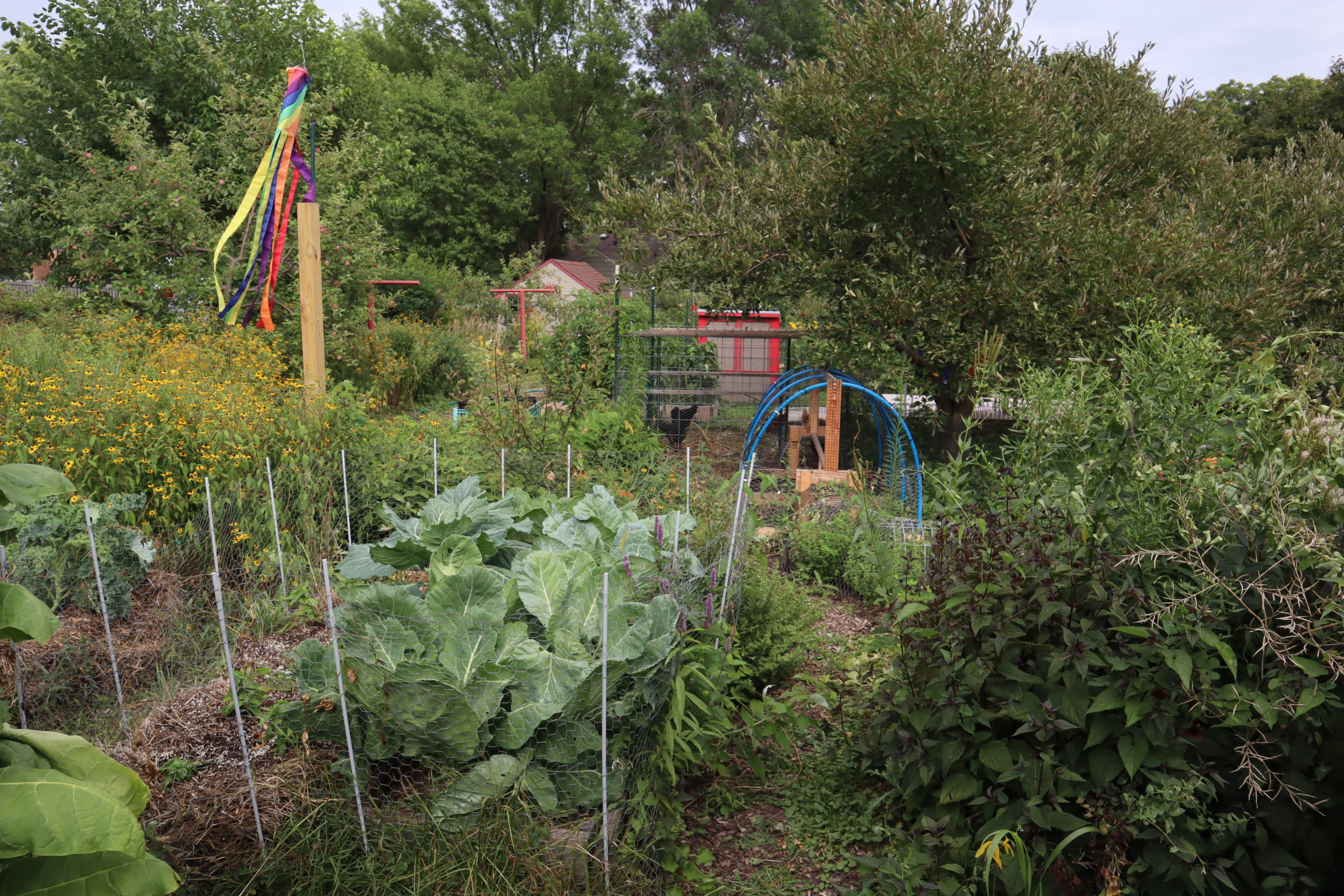There were comments on the Practical Farmers of Iowa listserv shortly after Thanksgiving Day this year (2020) about the practice of gratitude. I am grateful for those members who sent the messages and their reminders that practicing gratitude is extremely important for both spiritual and emotional health.
I began what I anticipated would be a short response but ended up writing at length about how Thanksgiving Day could be considered as an Annual Gratitude Day to remind people of the importance of practicing gratitude throughout the year. I also began writing about my personal sense of gratitude in relation to the spontaneous nature of Thanksgiving Day here in Ames. As a single person, like many other wise people who are keeping a great deal of social distance as the COVID-19 pandemic keeps surging, I felt my Thanksgiving connections and food were of as fine a quality as anyone could have experienced in more conventional family circumstances or in a less troublesome era.
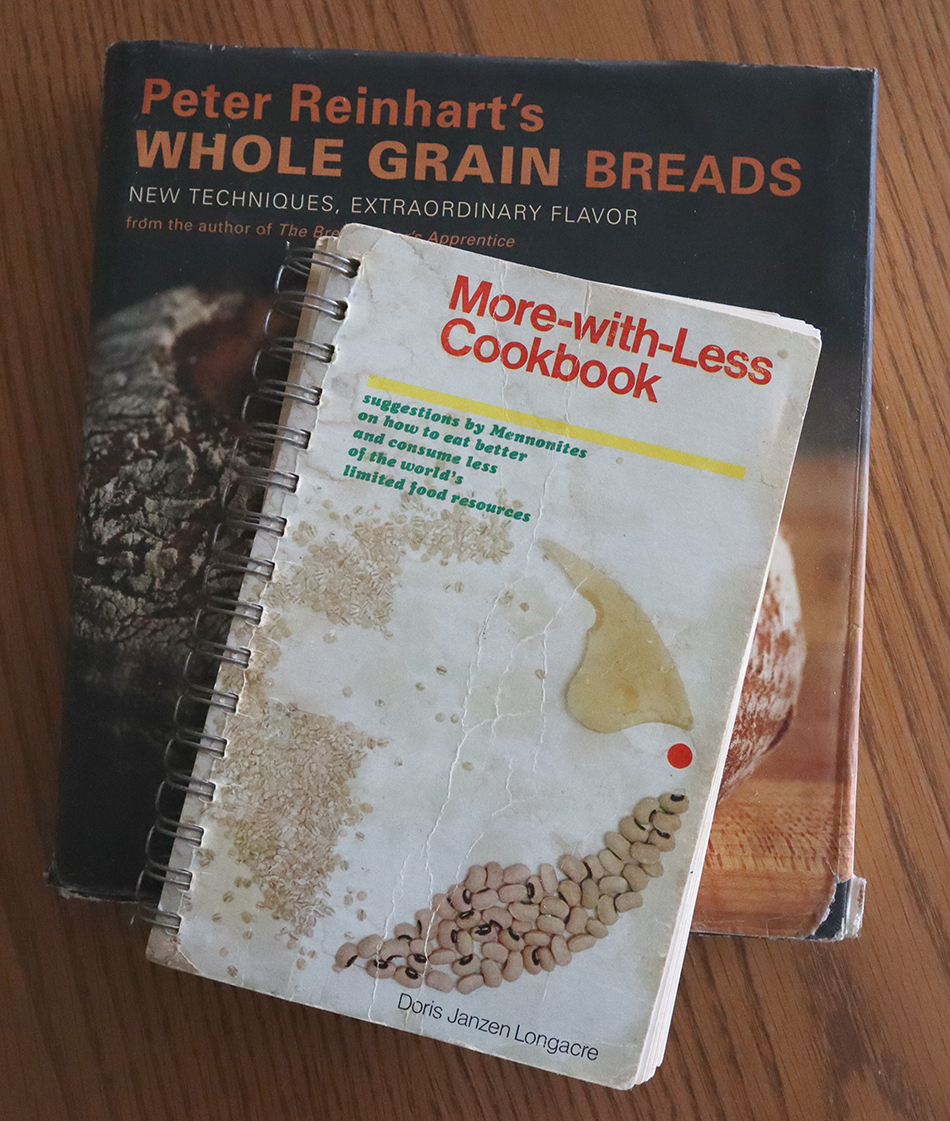 I am grateful for the Hafner family (Earl and Ronda and son Jeff) and their Early Morning Harvest Farm near Panora for delivery, upon request, of produce such as a bushel of apples or 25-pound bags of corn kernels or wheat berries. I am also grateful for the people who have helped me learn during the past 14 or more years how to make whole grain bread with great texture and taste using Iowa grown grain. Recently, I have returned to a bread stick recipe from the Mennonite’s More with Less cookbook and both a hearth bread recipe and a focaccia bread recipe but shaping dough from the latter two recipes into baguettes.
I am grateful for the Hafner family (Earl and Ronda and son Jeff) and their Early Morning Harvest Farm near Panora for delivery, upon request, of produce such as a bushel of apples or 25-pound bags of corn kernels or wheat berries. I am also grateful for the people who have helped me learn during the past 14 or more years how to make whole grain bread with great texture and taste using Iowa grown grain. Recently, I have returned to a bread stick recipe from the Mennonite’s More with Less cookbook and both a hearth bread recipe and a focaccia bread recipe but shaping dough from the latter two recipes into baguettes.
My mentors include Bill and Maribeth Lindsay, whom I met about 14 years ago. Bill was a grad student in agronomy. He, Maribeth, and some of their children baked bread, muffins, and other goods in their garage in the Somerset subdivision and sold it at the North Grand Market in Ames. Bill mentored me and led two bread-making workshops for a half dozen of us Unitarians in my kitchen. He also introduced me to books by Peter Reinhart. I am grateful to Peter for his research and presenting it in a way I could incorporate. His 2008 book, Whole Grain Breads, is my go-to bread book.
Nate Kemperman and Alice McGary are founders of Mustard Seed Community Farm north of Ames. Nate is also the bread baker for Wheatsfield Cooperative, my favorite store in Ames, and I love sharing bread ideas with him. I also like to support the farm. Its mission:
Guided by our faith and ethics, we are dedicated to sustainable, simple living, love of our neighbor, and creating a community in which everyone can participate in growing and eating delicious, healthy, locally produced food. Located north of Ames, IA, we have a small CSA and also grow food for the shelters and soup kitchens in the area. We also deliver gift boxes directly to families’ homes and partner with the Farm to Clinic gift food and nutrition program.
I love to heat olive oil in a cast iron skillet and place slices of the bread on their sides in the pan. I discovered the technique after divesting of my microwave oven and toaster years ago. I shake Cy Salt purchased from the Saltlickers company in Nevada (Iowa) onto the warm and moist bread and eat it with perhaps a couple of fried eggs from my laying hens. I use Cy salt daily–not because of any allegiance to the Cyclones (the nickname for the ISU sports teams) but because of such great-tasting seasoning. I am grateful to the Saltlicker folks, whose homepage says:

Somewhat unanticipated on Thanksgiving Day, I handed off whole wheat baguettes to a handful of friends who stopped by at different times. We wore masks and stayed our distance. Only one friend stayed for an indoor visit. Some merely picked up their loaves that I had placed on a wooden table in the driveway. Some visited with me in the driveway as we sat in chairs more than six feet apart in the cool but comfortable enough air.
One loaf went to veterinarian Abby Cowan Strobbe who brought dressing in a quart jar that I had sent home with her two weeks ago filled, at that time with a gift of my homemade kombucha. Two loaves went to Diane Ercse (sister of PFI’s Debra Boekholder). Diane rents the house next door from me and is the key manager/helper at my urban farm and a godsend in terms of the care she gives the place and the ways she supports me. She brought me several containers of TGD food. Then a loaf to Donna Prizgintas (well-known local foods advocate and a pretty much retired chef who has great alliances with PFI folk). Donna brought two pumpkin dessert dishes (one with ginger chews on top and the other a pumpkin cobbler with bourbon folded into the whipped cream topping). Another loaf went to a friend, Barb Wheelock whom I had met during the caucus season when we were both supporting presidential candidate, Amy Klobuchar. And I am grateful for the quality people (consider them as unsung heroes) who ran for office, staffed campaign offices, and volunteered to do the trench work of getting out the vote or administering the election process and vote count. Anyway, Barb had called to see if she could bring me TGD food. All this on Thanksgiving Day.

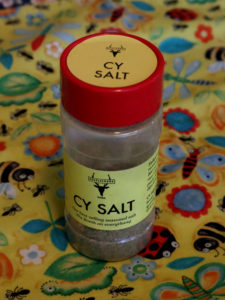 I shared my bread and the gifts of food with yet another friend, who does not like her name mentioned on the Internet. She brought fresh yellow roses in a vase for the centerpiece. We sat socially distanced at opposite corners of the large conference table in my living room with the windows wide open for fresh air. Then on Saturday, Geri Neal (former Leopold Center staff member) brought a celery and apricot salad and I provided warmed up slices of bread (again with Cy salt) and homemade kombucha for our meal as we sat across a table from each other on my orchard deck. I am grateful for how these people made my TG week so wonderful in an exquisite, yet simple style.
I shared my bread and the gifts of food with yet another friend, who does not like her name mentioned on the Internet. She brought fresh yellow roses in a vase for the centerpiece. We sat socially distanced at opposite corners of the large conference table in my living room with the windows wide open for fresh air. Then on Saturday, Geri Neal (former Leopold Center staff member) brought a celery and apricot salad and I provided warmed up slices of bread (again with Cy salt) and homemade kombucha for our meal as we sat across a table from each other on my orchard deck. I am grateful for how these people made my TG week so wonderful in an exquisite, yet simple style.
In other dimensions of my urban farming experience, I am grateful to Amber Anderson, a university soil scientist and urban farmer, who about 11 years ago arranged for me to have my first chickens since the time I had a flock for a high school 4-H project. Amber delivered five chicks that she had received in the mail the previous day and showed me how to dip the their beaks in water, teaching them how to drink. Then there is Marilyn Andersen who has been my call-to person for poultry advice and who has made all the woven rugs that are displayed around my house and some of my knitted stocking caps.
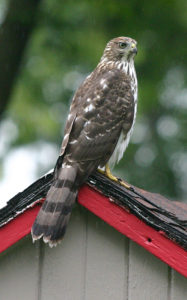
On the day after the 2012 presidential election, Abby, the veterinarian, helped me rescue a chicken named Addy from the center of the backyard. Addy (the chicken) had been attacked by a hawk or other predator with large wing span. Abby (the vet) did a great job of nurturing Addy, as she cradled Addy, spoke softly to her, applied raw honey to her wounds, and did acupuncture. Addy survived, not as long as the other chickens that had not been attacked even though they had been spooked, but she did have a good life. Click here to read more about the hawk attack and Addy.
I am grateful to the various part-time helpers at my urban farm who have built my chicken hotel, pens, and runs. There are too many helpers to remember and/or name for me to remember at any one time; however, there are some examples. One is Ames independent contractor, Kent Savely, whom I have learned not to describe as a “handyman” but as a friend who is versatile and resourceful and willing to hire on for a wide range of projects. When I would come up with an idea, he would hear the essence of what I was saying and make it into a real structure.
Bret Lang and Kristine Lang, who is a PFI board member, have also been key helpers. Bret extended the chicken hotel that is a corner in the garage so I could accommodate around 12 laying hens rather than a mere seven, and Kristine, who was an ISU doctoral student in horticulture at the time, applied her wisdom here. Am grateful, too, for Tom Jordan’s thoughtful and reliable help. Tom has been retired for several years after a career at the farmers cooperative in Randall and now lives in Ames with his own gardening service called Garden Therapy. He has hired on for a full portfolio of chores such as delivering loads of composted horse manure from the One Heart Equestrian Center north of Ames, doing the roto-tilling I occasionally have him do for my garlic plots, clearing brush, transplanting several trays full of prairie plant seedlings to start a large prairie patch, or constructing a wooden bridge over my chicken run.
I am grateful that I found this Ames home in 2006 and have enough space on this lot and the one I bought next door in 2013 for an urban farm and be able to raise chickens. It makes my day to connect with them. Sure, I do not like it when the chickens escape unauthorized from their pens, for instance, when I go out in the morning and see them running around the yard and realize I forget to close their gate at night. I have strategies for catching them, however, which is not so easy for a person on 75-year-old legs with a tender hip. But once I catch a hen, I love cradling it as I carry her back to her designated area. I also love cradling one to hand off to a young visitor so the chicken and visitor can befriend each other. I also love it when the chickens come near my orchard deck either when I am visiting with a friend or doing yoga by myself. Sometimes they will roost at length on a cross bar in the nearby pen and simply enjoy being present to what we humans are doing.
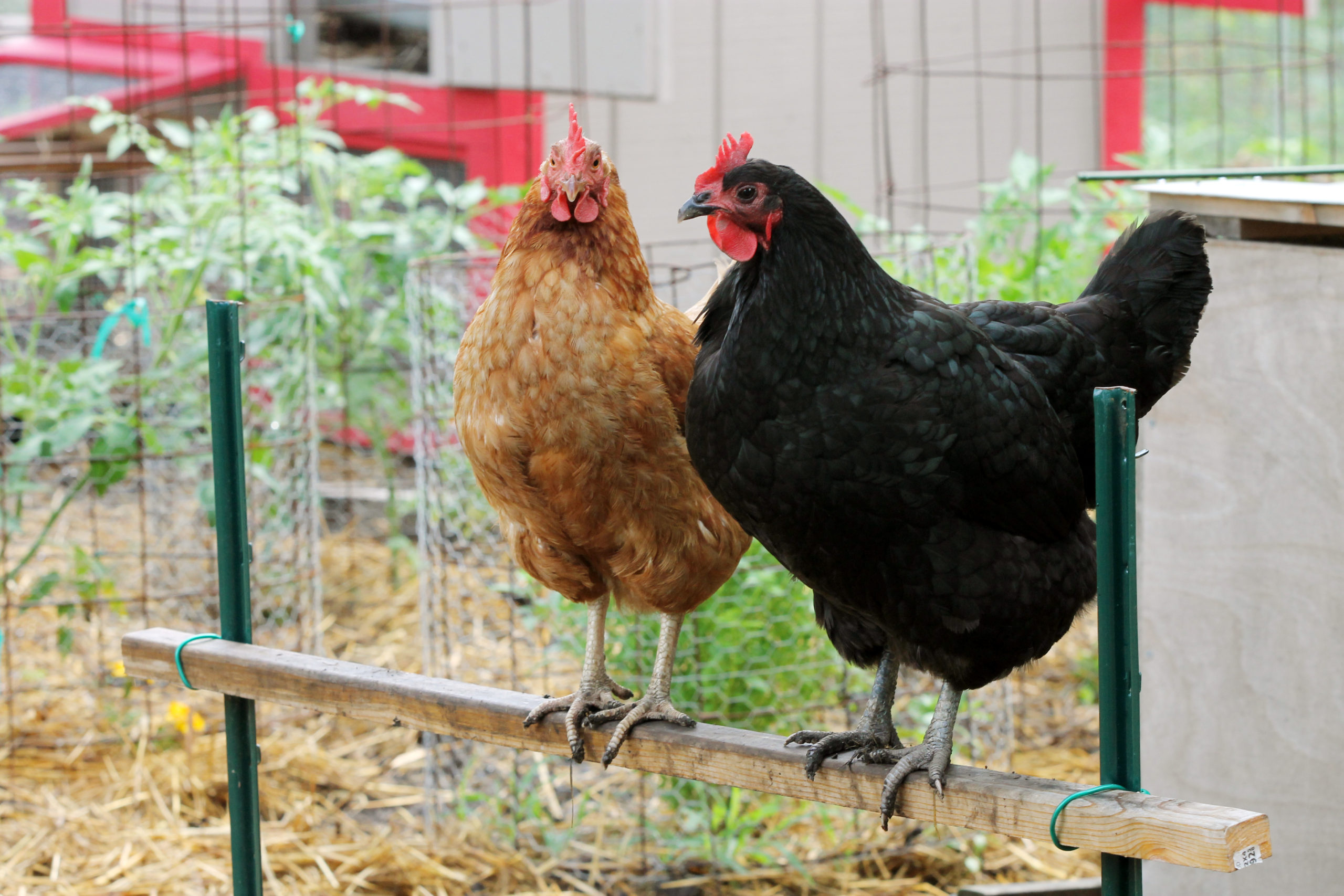
I appreciate the chores of filling the waterer and feeder and have a good chuckle when I let the chickens escape their runs during the hour before their bedtime so they can access the entire backyard before they voluntarily return to their hotel when darkness sets in. Such beauty and good energy to behold when I open the gate and they sprint, then soar for a flight of several feet on their way to the extreme back part of the yard where they love to scratch in the soil at the previous site of the compost bin. The chickens know when it is that time–the time that I will let them out if I remember. They come running from wherever they have been roaming, resting, or scratching in their tunnel system, then exit to the full yard taking flight. The tunnel system is like a large toy train track system around the yard with large sections made of heavy duty, metal hoops. The hoops were once guards for corn crib tunnels for the augers that conveyed ear corn out of the cribs when it was time to shell the corn.

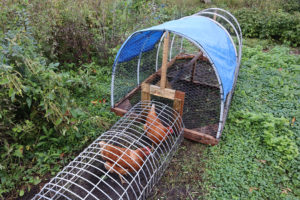 I am grateful that one of my farm tenants, Denny Flaherty, in Pocahontas County, was able to find perhaps 40 guards for me, often following leads he got from other farmers at morning coffee time in town. I am grateful, too, for other folk who have constructed tunnels with a design I invented that uses PVC pipe and wire. Two of the helpers were Diane Ercse and her brother, Brian Boekholder. And, of course, I am grateful to Brekkes Town and Country Store just east of Ames where I buy the baby chicks and Hoover Hatchery in Rudd, Iowa, that breeds the chicks. There are so many folks at Brekkes, including Mel and Chuck Brekke (father and son) who make me feel nearly like family and who will deliver, at no charge, bags of chicken feed (and sometimes cat food and litter), open my garage door and place the goods inside. And of course, there are farmers and corporate workers fully unknown to me who grow the grain and produce the feed mix.
I am grateful that one of my farm tenants, Denny Flaherty, in Pocahontas County, was able to find perhaps 40 guards for me, often following leads he got from other farmers at morning coffee time in town. I am grateful, too, for other folk who have constructed tunnels with a design I invented that uses PVC pipe and wire. Two of the helpers were Diane Ercse and her brother, Brian Boekholder. And, of course, I am grateful to Brekkes Town and Country Store just east of Ames where I buy the baby chicks and Hoover Hatchery in Rudd, Iowa, that breeds the chicks. There are so many folks at Brekkes, including Mel and Chuck Brekke (father and son) who make me feel nearly like family and who will deliver, at no charge, bags of chicken feed (and sometimes cat food and litter), open my garage door and place the goods inside. And of course, there are farmers and corporate workers fully unknown to me who grow the grain and produce the feed mix.
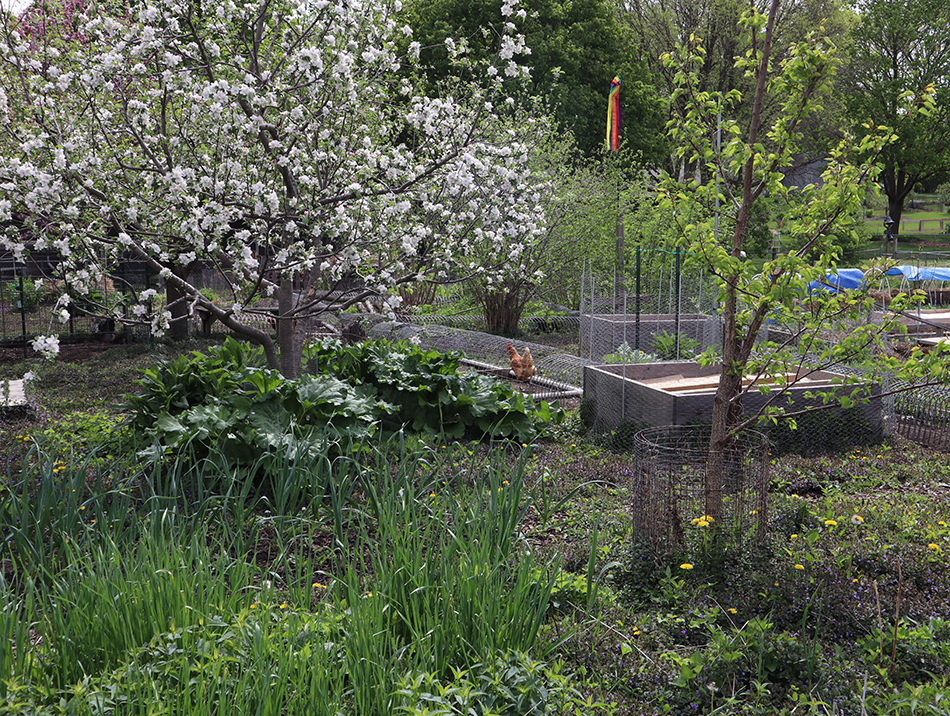
Vic and Cindy Madsen of Audubon County Family Farms have advised me at times on so many aspects of farming, whether my urban farm or managing my farm land. In particular, I think of Vic’s advice about the importance of buying feed that is a scientifically perfected mix of grains, minerals and other supplements rather than feed the chickens grain grown on my own farm. He says that serving the chickens just grain is like serving humans a diet of potato chips. The temptation is to eat the junk food.
When I reflect on the success of the past season of growing apples here, I recall the helpful advice that many folks have given me: Dean and Judy Henry of the Berry Patch Farm between Ames and Nevada; Tom Wahl and Kathy Dice or Red Fern Farm in southeast Iowa; Patrick O’Malley of ISU Extension; Steve Carlson with PFI; PFI members Steven and Ethy Cannon of Ames; and Brandon Carpenter of the ISU Horticulture Farm. Brandon’s advice last spring regarding conditioning newly-grafted trees in a controlled environment took my grafting skills to a new level of success. I had the healthiest looking baby apple trees this year, and one is at home in my backyard while others have gone to friends.

I am grateful for PFI inviting me to the cooperators dinners over the years even though I have no aptitude for doing research. The meals have been part of PFI’s annual two-day set of workshops for cooperators–meaning people who are conducting on-farm research that meets PFI’s protocols. It was at one of those banquets, when each of us at the dinner had a chance to take the microphone and say what we were curious about, that I asked for help learning to graft apple trees. After the program adjourned, Tom Wahl introduced himself to me and said he could help. The rest is history. Grafting new trees is an annual ritual for me, and Steve Carlson is my key compatriot.
Of course, I am grateful for Denny Flaherty farming for me for nearly three decades before retiring a year ago and his farming partner, Jeff DeWall, who continues to farm some of my land. I am grateful beyond words for Abram Frank who is now farming most of my land and transitioning to organic. I would be remiss mention my gratitude for Betsy Dahl, who was the first to take on the challenge of farming my land organically and continued at it for about 10 years.
My land is inherited through no virtue of my own, and it would have little value or meaning to me if there were not amicable people willing to pay rent at a healthy, yet moderate level, and farm with agricultural and environmental values consistent with mine. I have never been happier about the potential for my land than now that Abram is farming. He recognizes the issues of water and soil quality, climate change, and agriculture and is willing to think outside the box. His vision is to produce organic food products to sell directly off the farm. I have told him about the Hafner farm and am hoping he gets a chance to visit sometime with Earl and Jeff. Abram also wants to experiment on a small parcel of my land, growing cover crops in conjunction with organic practices. He does have a cattle herd and envisions implementing regenerative agriculture. Indeed, he is bringing cattle back to agriculture. Not yet on my land, but someday in the near future. I am wondering if the late Dick Thompson, one of PFI’s founders, who warned that removing cattle from agriculture would ruin agriculture, is watching my computer monitor or reading my mind as I write.
I am grateful for Art Cullen’s work. He is editor of the Storm Lake Times, and I am reading his book Storm Lake. Since the town of Storm Lake is not far from my hometown of Rolfe, I am familiar with much of the terrain and many of the people he covers in the book. I found it hard, however, to track his thoughts in several sections, but perhaps that is because of my not so great reading skills. It would be valuable for several PFI members to read and discuss Art’s book, especially the chapters about soil and water quality, climate change, and agriculture.
I am grateful to former PFI director, Teresa Opheim, for editing the book The Future of Family Farms with the support of the PFI board in 2015. If you look closely at the cover of her book in the faded plat map that constitutes the upper part of the design, you will see the land owned by her grandparents, Bill and Vera Fisher, northeast of Rolfe. Further south on the plat map, hidden behind the tree line of the overlaid farm photo, is a large parcel of my land. I call it DeElda Farm in honor of my farming grandmother. It has a large permanent pasture, 77-acre pollinator habitat, and 90-acre crop field that Abram farms. I have already given 60 acres of that land outright to the Iowa Natural Heritage Foundation and the rest to the Foundation in a reserved life estate arrangement.
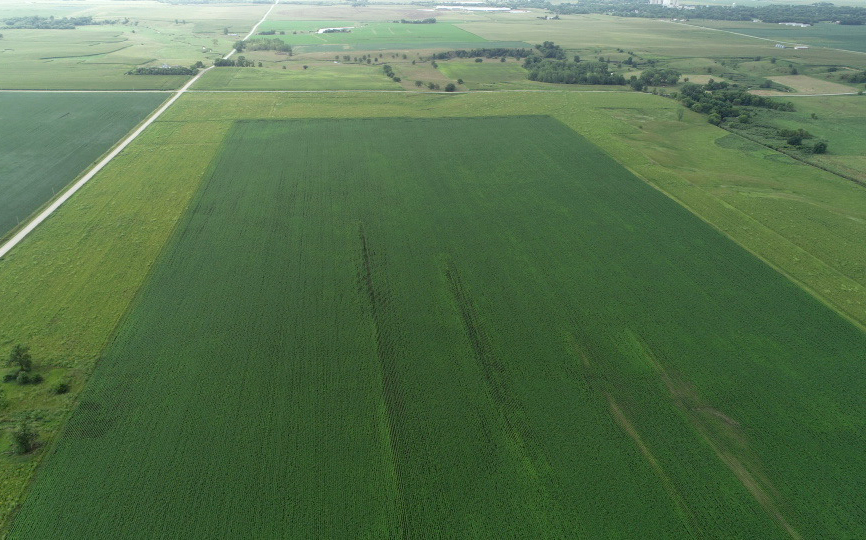
I am grateful to the INHF and the work it does. I appreciate that Joe McGovern, INHF President, was willing to write an endorsement for my book. I love my connections with Joe as well as with many of the staff members, especially Lisa Hein and Erin VanWaus, who listened to my laments a few years ago about some management issues and mentored me well so I could make a good decision about finding a new tenant. I appreciate how Ryan Schmidt has managed the prairie restoration project at DeElda Farm. I have no heirs to whom I would choose to bequeath my land, and I have not liked the potential risk of leaving my land in my will and have someone else challenge and screw up my stated intentions. I fully trust the INHF to be a conscientious steward and continue working toward some of the visions I hold. Eventually, some of my other land will go to PFI. I am ever grateful for my connections with so many PFI folk as friends and mentors and for the work of the organization. PFI feels like family.
If you have excellent eyesight and would look closely at the cover of Teresa’s book, you will see in the fine print on the plat map the land owned by the Hancher family northeast of Rolfe around a century ago. Yes, Virgil Hancher, President of the University of Iowa from 1940 to 1964, got his start on a farm not far from Teresa’s family land and my land. I have been told that Virgil and my great aunt, Martha Gunderson, were fond of each other but that my great grandparents, Dena and Charles Gunderson, did not hold Virgil in high enough esteem to allow him to have a future with their daughter.
Thank you, Teresa, for working with the University of Iowa Press to publish book and to all of you from PFI who wrote for it. I already knew some of your stories, but I learned more. Others, I did not know, but am proud to know about you now. The book is a blessing in the ways it shares stories and perspectives. Suggestion to the leaders of PFI: please consider collecting more stories of PFI folk whether farmers, landowners, staff members, or other friends of agriculture and publish a sequel.
The practice of gratitude can open portals to let out let out bad energy resulting from thinking about personal challenges or ruminating on the pressures of the times and let in good energy–not with a Pollyanna attitude–but simply by active free association of thoughts and memories of the fine people and fine gifts in our lives. This is not some kind of “power of positive thinking” that denies the negative. This is simply taking the crust off of life, akin to raking up matted dead leaves in the yard, to find the good, life-giving energy below that crust and allow for healthy growth. For me, I can avoid writing like the plague, but once I start, even with the idea of writing a mere, simple thanks to those on the listserv who started this conversation, I can become a long-winded writer.
Sunday, I slept most of the day. Perhaps I slept at length due to full plates of TGD food for three days in a row. Perhaps I rested because during those same three days, I had finished deep-cleaning two rooms in the basement, the screened-in porch, and the shed at the back of the yard as part of transitioning from the outdoor growing season to the dormancy of winter. Perhaps my weariness was the aftermath of spending several hours watching the Netflix film, The Queen’s Gambit, which I loved, but too much screen time can make me weary. Perhaps my mood was low as a result of hearing the sound of the strong winds and seeing the gray skies that forecasted the onset of the dormant season even though I appreciate the dormant season. Perhaps, too, my low energy resulted from being unable to ignore some of the tragic realities happening in this world in this era.
 My antidotes for low moods or energy? Sautéing vegetables and/or cooking eggs in cast iron skillets for a meal, baking bread, making apple butter, fermenting kombucha or yoghurt, sharing food (whether from my urban farm or local farmers), talking on the phone with friends, befriending my four cats, feeding my chickens, doing yoga, riding my bicycle or walking, and writing are all a boon to my health. Would my high school teachers or classmates ever have imagined that this farm girl with more interest in being outdoors for sports and farm work than school work would end up benefitting so much from writing?
My antidotes for low moods or energy? Sautéing vegetables and/or cooking eggs in cast iron skillets for a meal, baking bread, making apple butter, fermenting kombucha or yoghurt, sharing food (whether from my urban farm or local farmers), talking on the phone with friends, befriending my four cats, feeding my chickens, doing yoga, riding my bicycle or walking, and writing are all a boon to my health. Would my high school teachers or classmates ever have imagined that this farm girl with more interest in being outdoors for sports and farm work than school work would end up benefitting so much from writing?
If you haven’t done so already, experiment with a gratitude practice. Simply start with a pad of paper and pencil. The activity is better than keeping the practice all in your mind, but the imagination works, too. Simply go into free association mode and remember little things (or bigger) that you are grateful for. There may be times when the memory of someone or some event that had been unpleasant in our lives will surface and we can find a way to be grateful for them.
I could go on and on. But I will mention only one more element of what is happening in my life that indeed makes me grateful.
I recently had my web site completely revamped after it had been dormant for years. The main impetus for making the change was to have it focus on my book about my rural heritage. That book, titled The Road I Grew Up On: Requiem to a Vanishing Era, has been in the making for 30 years and should be available maybe by the middle of this month. Otherwise, I will have to say it has been 31 years in the making, which is not so poetic.
I am grateful for so many people who have helped make this possible. My parents are two of those people. Although I have not been appreciative enough of them (my mother, Marion Gunderson, who died in 2004, and my father, Deane Gunderson, who died in 2010), it is through their half century of estate planning and the estate planning of my grandmother DeElda Gunderson in the 1950s, that I have the land and financial resources that have allowed me to have the lifestyle that I do. This foundation has allowed me to purchase, develop, and live on an urban farm; have the time to write and pursue photography; and be able to hire a local printing company to publish the book. My parents also modeled and nurtured an interest in local history. I also need to salute my older sister, Clara Hoover, of Omaha for her extensive help in so many ways, especially in the last year when I turned to her often for proofreading and research help.
I could write another 10,000 words about people who have helped make the book a reality. I won’t except to say that I am extremely grateful to Teresa Opheim for writing the foreword and to PFI’s current director, Sally Worley, PFI member Cornelia Flora, and others for writing endorsements. It also has been a real honor that Sally and other staff members, including Tamsyn Jones, arranged to print Teresa’s foreword in the latest PFI magazine. I believe Heuss Printing has made the last corrections to the book. Oh, my goodness, there have been so many different rounds of reviewing proofs. Publishing a book can be grueling work even after submitting manuscript. Writing the chapters is easy relative to the marathon of reviewing those proofs, emailing lists of corrections to the printers, waiting to see the next set of proofs, and dealing with the anxiety of the finish line moving further away.
I am grateful that Kori Heuss and her graphic designer, Laura, have persisted with me during the marathon of the past year to finish the book. Most of the book was completed in 2004, but I could not bring myself to write the last chapter. Finally, in December 2018, Beth McNeil, Dean of the ISU Parks Library, and I met for lunch. She surprised me by saying the library had a new digital press and would be willing to post a digital version of my book on its server. All I needed to do was write the last chapter. Fortunately, Adam Wright, who earned masters degrees in writing, the environment, and sustainable agriculture at Iowa State, was available as a great writing mentor in 2019. Harrison Innefuku at the ISU library has been helpful, too, as have the interim library dean, Hilary Seo; associate dean, Curtis Brundy; and the staff at the Special Collections Department who keeps my collection of documentary materials safe, sound, organized, and available, for the most part, to the public. Also, I am grateful to Daniel Hartwig, head of ISU Special Collections and University Archives, for writing an endorsement for the book.
Mary Bennett based in Iowa City with the State Historical Society also wrote an endorsement for the book. I have known Mary since perhaps the 1970s and am grateful for her long tenure of commitment to preserving and making Iowa history materials accessible. I also am grateful for how she has had my back all these decades either providing photos, answering questions, or cheering me on with my work.
I love the new look of this redesigned web site and appreciate the work that the design team at Saltech in Ames put into the site.
My advice, if you have never thought much about writing, try it, even if short notes and on an irregular schedule. There are many valuable forms of writing, and a person could probably discover one to be an antidote for so much that can ail a person.
